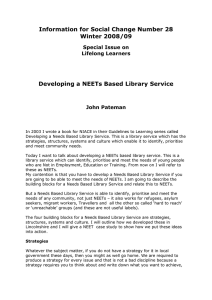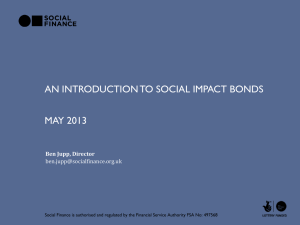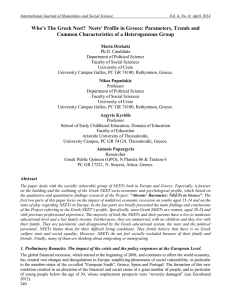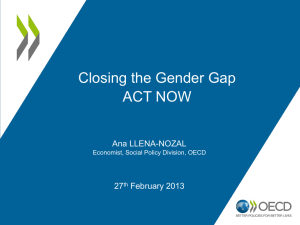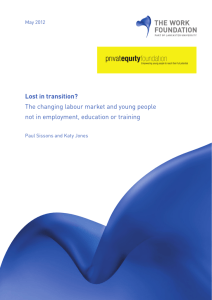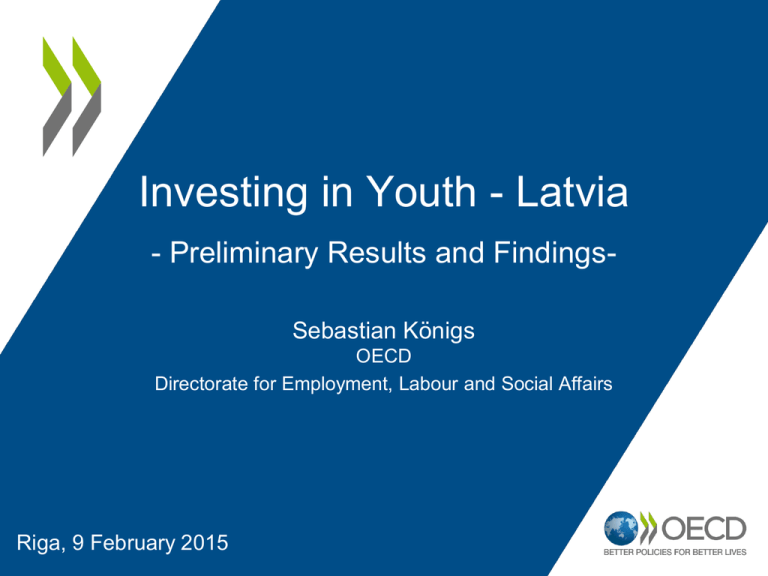
Investing in Youth - Latvia
- Preliminary Results and FindingsSebastian Königs
OECD
Directorate for Employment, Labour and Social Affairs
Riga, 9 February 2015
State of affairs: on-going / upcoming
country reviews
• Missions in 2014: Australia, Latvia and Norway
• December 2014: Issues Paper on Investing in Youth
• February 2015: Working Paper: “NEET Youth in the Aftermath of the
Crisis”
• Missions planned for 2015 (so far): Sweden and Japan
2
Scope of the Latvian country review
1. Youth in the Latvian Labour Market
2. Who are the NEETs?
3. Income support and poverty among youth
4. Reducing school drop-out and providing disadvantaged
youth with relevant professional training
5. Offering NEETs an effective programme guarantee
3
Youth in the Latvian Labour Market
The youth population has shrunk
dramatically over the last decade
left panel: size of the youth population (right axis: absolute count, left axis: relative rate)
right panel: change in the youth population in %, 2002-13
1. Statistics are for young people aged 15-29 years.
Source: OECD calculations based on the Latvian LFS and CSB data
5
Young people have been hit hard during
the economic crisis
left panel: employed youth as a share of the total youth population (in %)
right panel: unemployed youth as a share of all active youth (in %)
1. Statistics are for young people aged 15-29 years.
Source: OECD calculations based on the Latvian LFS and OECD Employment Database
6
The recovery of employment rates was
largely due to a demographic effect
left panel: youth employment rate, observed and anchored at the population of 2007 (in %)
right panel: absolute change in the number of employed youth by sex and level of education
Changes in Youth Employment
2010-13
2007-10
women
10,000
women
men
women
men
men
0
-10,000
-20,000
-30,000
-40,000
-50,000
low educated
1. Statistics are for young people aged 15-29 years.
Source: OECD calculations based on the Latvian LFS
medium educated
highly educated
7
16% of youth in Latvia are NEET, only
8% combine study and work
Labour market status of youth in %, 2012/13
1. Statistics are for young people aged 15-29 years.
2. Results are for 2012 except for Latvia (2013).
Source: OECD calculations based on the Latvian LFS, EU-LFS and national LFS
8
Who are the NEETs?
The jump in NEET rates during the
crisis reflects a rise in unemployment
inactive and unemployed NEETs as a share of the total youth population (in %)
1. Statistics are for young people aged 15-29 years.
2. Left panel: results are for 2012, except for Latvia (2013)
Source: OECD calculations based on the Latvian LFS, EU-LFS and national LFS
10
Nearly all NEETs are 20 years and above, and
among women, many older NEETs are inactive
Breakdown of the number of
NEETs by age group (in %)
NEET rates by sex and age (in %)
women
15-19
20-24
men
25-29
15-19
20-24
all
25-29
15-19
20-24
25-29
8
9
9
11
48
11
43
12
10
17
15-19
2
3
10
2
5
2
6
6
12
8
4
20-24
unemployed NEETs
unemployed NEETs
unemployed NEETs
25-29
inactive NEETs
inactive NEETs
inactive NEETs
Source: OECD calculations based on the Latvian LFS
11
NEET status and education are closely related,
but most NEETs have gone beyond Year 9
Breakdown of NEETs by
educational attainment (in %),
15-29 year-olds
NEET rates by sex and educational attainment (in %),
25-29 year-olds
low
medium
all
men
women
high
low
medium
high
low
medium
high
19
18
30
17
52
40
10
15
4
18
13
11
12
12
7
low
4
22
5
1
11
9
medium
unemployed NEETs
unemployed NEETs
unemployed NEETs
high
inactive NEETs
inactive NEETs
inactive NEETs
1. Low education: ISCED 0-2; medium education: ISCED 3-4; high education: ISCED 5-6
Source: OECD calculations based on the Latvian LFS
12
NEET rates are higher for non-ethnic Latvians, who
account however for the minority among NEETs
Breakdown of the number
of NEETs by ethnicity (in %)
NEET rates by sex and ethnicity (in %)
ethnic
Latvians
men
women
all
other
ethnicities
ethnic
Latvians
other
ethnicities
ethnic
Latvians
other
ethnicities
9
39
11
61
7
7
14
15
8
ethnic Latvians
other ethnicities
10
10
7
6
6
unemployed NEETs
unemployed NEETs
unemployed NEETs
inactive NEETs
inactive NEETs
inactive NEETs
Source: OECD calculations based on the Latvian LFS
13
NEETs are much more likely to suffer from health
problems, and this is especially true for males
Share of individuals who report health problems, by subgroup in %
1. Statistics are for young people aged 15-24 years only.
2. The sampling weights used for producing the numbers have not been adjusted after the 2011 census.
Source: OECD calculations based on the European Health Interview Survey, 2008
14
Over a 4-year period, nearly half of all youth in
Latvia have had at least one NEET spell
… and one out of three youth have a spell of 7 months or longer.
Number and length of NEET spells among
youth over a 48-month period (in %)
1. Censored spells are included at their observed length.
Source: EU-SILC, longitudinal panels 2008-12
Panel data analysis:
•
Each young person is
followed over 48
consecutive months
•
sample members are aged
15-29 yrs at the beginning
of the observation period
•
Individuals’ observation
periods start in 2005-9
(and finish in 2009-12)
•
NEET spells may represent
periods of unemployment
or inactivity
15
Single parenthood, the lack of skills and bad health tend
to favour repeated or longer NEETs spells
Individual characteristics by benefit spell pattern (in % of all individuals)
1. The listed variables indicate whether an individual with a given benefit spell pattern was a single parent / had low
educational attainment / suffered from bad health at one of the four annual measurements during the 48-month
observation period.
Source: EU-SILC, longitudinal panels 2008-12
16
So, who are the NEETs…?:
Predominantly in their 20s…
70% with more than just Basic Education
Every second one not looking for work (and the share is
higher than that among women…)
NEET rates are higher among non-ethnic Latvians, but
they account for only 40% of all NEETs
More than 1 out of 4 with health issues…
40% of NEETs out of employment or training for
over a year
What’s still missing…?
1. the importance of geographic location
2. views and values
17
Benefit Receipt and Poverty
among Youth
UB receipt among youth reacted strongly during
the crisis but is back to pre-crisis levels
Annual receipt rates of individual-level benefits among youth (in %)
1.
2.
Statistics are for young people aged 16-29 years.
Benefit receipt rates give the number of youth who report having received a positive amount of benefits during the
calendar year as a share of the total youth population.
3. The share of individuals who received both UB and DB is negligible and therefore not displayed in the left panel.
Source: OECD calculations based on EU-SILC
19
UB spell durations tend to be short, but less than
half of all young jobseekers qualify
Unemployment spell durations and numbers among youth registered
during the crisis (Jan 2009 – Dec 2011)
Duration in months of unemployment
spells among those registered (in %)
1-6
7-12
13-24
25+
41.7
31.0
22.0
5.3
Number of separate unemployment
spells among those registered (in %)
1
2
3
4+
76.9
19.0
3.6
0.5
Share of youth who received UB or DB among those registered as
unemployed
Share of those registered unemployed during the
crisis who received UB or DB
Unemployment Benefits
Disability Benefits
46.3
2.9
Total benefit receipt duration among recipients (in months)
Unemployment Benefits
Disability Benefits
1-6
7-12
13+
1-6
7-12
13+
56.1
42.5
1.4
6.3
7.3
86.4
1. Statistics are for young people aged 15 years or above in January 2009 and not older than 29 years in December 2011.
Source: OECD calculations based on administrative data
20
SA and HB receipt rates have strongly risen
since 2007; the opposite is true for FA
Annual benefit receipt rates of household-level benefits among youth (in %)
1.
2.
Statistics are for young people aged 16-29 years.
Benefit receipt rates give the number of youth who report living in a household were some household member received a
positive amount of benefits during the calendar year.
Source: OECD calculations based on EU-SILC
21
Targeting of benefits is relatively weak, leading to low
benefit receipt and higher poverty among unemployed
Total Benefit Receipt rates, by subgroup in %
2013
60
69
2013
2007
84
56
Poverty rates, by subgroup in %
62
77
17
26
28
2007
23
22
31
1.
2.
Statistics are for young people aged 16-29 years.
Benefit receipt rates give the number of youth who report receiving unemployment benefits or disability benefits or
who live in a household were some household member received social assistance, housing benefits or family
allowances during the calendar year.
3. Individuals are defined as poor if they live in a household with an equivalised household income below 60% of the
median income.
Source: OECD calculations based on EU-SILC
22
Next steps
Scope of the Latvian country review
1.
Youth in the Latvian labour market
2.
Who are the NEETs?
3.
Income support and poverty among youth
4.
Reducing school drop-out and providing disadvantaged youth with
relevant professional training
5.
–
identifying at-risk youth early
–
coordinating social service providers, schools and other actors to effectively address
barriers to school attendance
–
supporting transitions into professional training for the most disadvantaged
Offering NEETs an effective programme guarantee
–
reaching out to those not in employment, education or training
–
tailoring solutions to young people’s individual social and educational needs
–
providing ‘second-chance’ learning options to those with a lack of basic skills
24
Timeline
• End of March: delivery of a draft report
• Early April: stakeholder seminar to present results and gather
feedback (to be discussed…)
• End of April: delivery of the final report
25
Thank you!
Contact: Sebastian.Koenigs@oecd.org
OECD Directorate for Employment, Labour and Social Affairs: www.oecd.org/els
Pensions at a Glance 2013: www.oecd.org/pensions/pensionsataglance.htm
Society at a Glance 2014: www.oecd.org/social/societyataglance.htm
Employment Outlook 2014: www.oecd.org/employment/outlook
Newsletter: www.oecd.org/els/newsletter
@OECD_Social
26
Supplementary slides
Fertility rates plummeted in the early-/mid-1990s, and
their recovery has been interrupted by the crisis
Total Fertility Rate, 1970-2013
1.
The Total Fertility Rate gives the number of children a woman would on average bear during her lifetime given the
prevailing age-specific fertility rates. The Replacement Fertility Rates gives the average number of children per woman
needed to hold the population constant at given mortality rates. It is approximately 2.1 in developed countries.
Source: CBS
28
NEETs are much less likely than other youth to live with
their parents, but the gap has fallen during the crisis
Left panel: household types among youth and NEET youth (in %)
Right panel: the share of youth and NEETs living with their parents, 2005-13 in %
1. Statistics are for young people aged 16-29 years.
Source: OECD calculations based on EU-SILC
29
15% of NEET spells in Latvia last at most 3
months, while over 40% last longer than one year
Duration of NEET spell lengths over a 48-month period (in % of all NEET spells)
1. Lengths of NEET spells observed for a sample of 15-29 year-olds over a period of 48
months during the period 2005-12. Censored spells are included at their observed lengths.
Source: EU-SILC, longitudinal panels 2008-12
30

